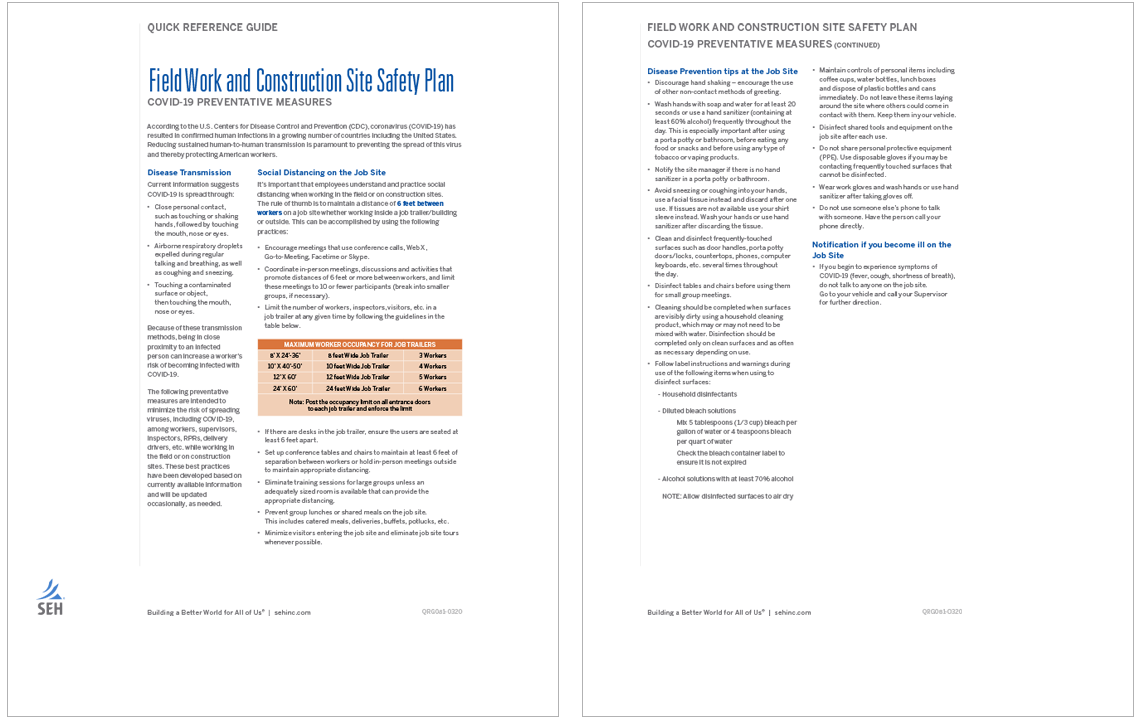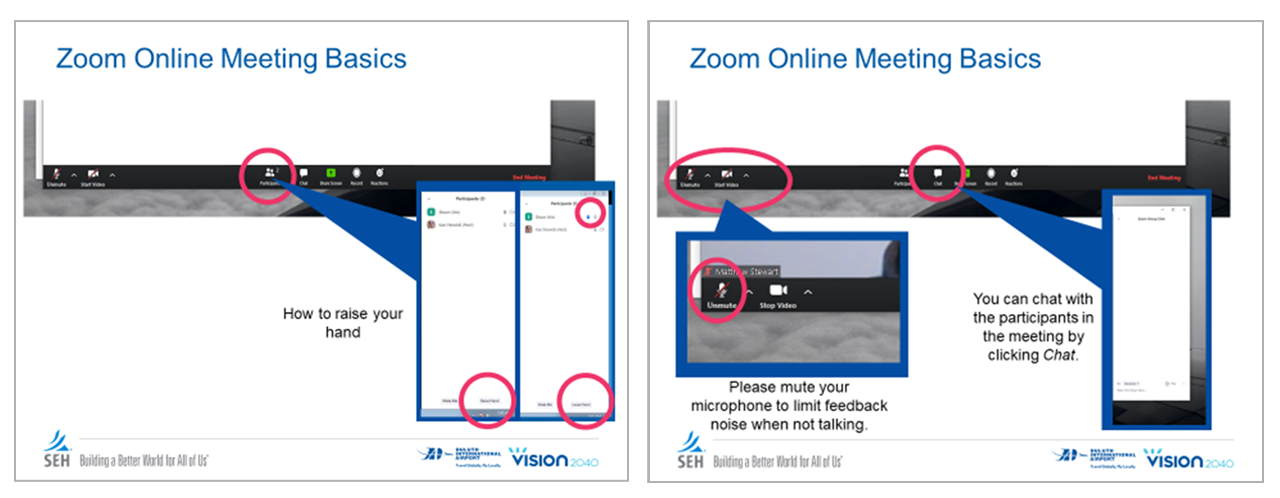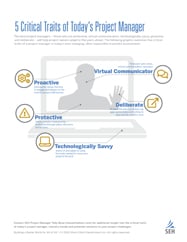Today, the daily lives of many are extremely different. Though some things will return to how they were previously, it’s important for project managers and their teams to embrace and adapt to a new normal.
The pandemic has brought many changes to the world of work; some are temporary but others permanent, especially those that save costs and time. For example, in-person public engagement will return but, as a precaution and recognizing opportunity for efficiencies, some events will be held virtually. Certain project phases – such as online bid openings, as explored below – will eventually replace traditional methods entirely. Ultimately, the pandemic has reaffirmed the need for A/E project managers and project owners to think differently.
As an engineer and project manager working remotely, seeking to help clients through this new normal and learning to adapt – the following graphic shares five traits I've found to be critical in today's ever-changing, unpredictable environment. Project managers who carry these traits, to name just a few, will be best positioned to help project owners adapt in the years ahead.

Expanding on the 5 critical traits (and how to spot them)
1. Protective
“Safety first” is a forever commitment – for project managers, this means protecting project teams, stakeholders, the communities within which we work, our families and the general public at all times. The global pandemic may have reemphasized the need for safety, but the best project managers have always and will continue to prioritize the health of the communities we serve.
Certain project phases, such as design reviews and site visits, will often be handled behind computer screens and through virtual communication in the months ahead. However, once construction arrives, workers need to be on-site. In response, every project team should have pandemic site safety response plan as part of their overall site safety response plan.
At SEH, project managers are providing clients with pandemic site safety response plans well in advance of shovels hitting the dirt. Our project managers also proactively hold standing agenda items to review in-place site safety plans, asking questions like: “Are workers and the public practicing social distancing” and “Have you observed the public getting too close to construction?” If the public is inching too close, we work with our clients to engage and educate public safety staff.

By providing and carefully walking through plans like you see above, project managers have the opportunity to remove ambiguity, discomfort and confusion around how the project will progress when construction commences and various team members visit the site. This is one small step project managers can take to protect the well-being of all; it must also be part of an overarching strategy and fundamental commitment to safety rather than solely a reaction to a current event.
2. Virtual Communicator
Like many across the professional landscape, at SEH nearly all of our employees have temporarily moved to home offices as a means to protect our people and the clients we serve. Where we work will undoubtedly shift in the days ahead, but the need for years to come remains true: today’s project managers need to be agile in the face of sudden change and capable of communicating well when circumstances shift without notice.
As a project manager working remotely right now, I spend a significant amount of time in virtual meetings with clients. To provide the information needed, rather than solely relying on phone calls or email, I am also using video conferencing tools like Zoom, GoToMeeting, WebEx, Skype, FaceTime and Microsoft Teams to ensure critical information is clearly presented. We need to become proficient with these tools to be an effective project manager in this new environment.
My colleague Kaci Nowicki recently held an airport master plan meeting with a client using Zoom. Not all attendees were familiar with the tool, so she kicked off the meeting with an explanation of important features – including how to screen share and let others take control of a presentation. Clear and timely communication are integral to every project. Today, for project managers this means being proficient in our use of virtual communication tools. Tomorrow, it may be a new way of communicating. Ultimately, we live in an era of constant change that demands non-traditional thinking and a willingness to evolve.

Most of our project and construction meetings are being held virtually right now – saving our clients/project owners money because our reimbursable expenses and time traveling to/from meetings have been eliminated. This has become a win-win, as it allows our project teams to focus more on delivering exceptional service while providing value elsewhere within the project.
3. Technologically Savvy
Strategic project management in this new normal extends far beyond online meeting tools and video conferencing. Project managers need to wield the technology tools available to move projects forward as efficiently and strategically (if not more so) as they would through traditional methods. Examples of these tools include online bid openings, replacing time-consuming tasks with automation and real-time, virtual site tours through the use of drones:
Online Bid Openings
Based on necessity, SEH project managers have transitioned to conducting project bid openings via webinar format within virtual bid rooms; we partner with the QuestCDN virtual bid network which has been highly effective, though there are many available tools to help you move forward. Simply stated, online bid openings are saving project owners and contractors money.

Traditional project bidding often involves project teams uploading project documents; contractors downloading/printing the necessary forms and hand-writing unit costs; then mailing or dropping off the documents in person. From here, the project team and some contractors travel to a bid opening site; open each paper bid by hand; read the bids aloud; and, following the opening, the project owner or consultant completes a time-consuming data entry exercise to check for mathematical errors.
Online bidding is the opposite. Bids are submitted online by a set deadline and automatically (in minutes rather than hours) uploaded to a single, reviewable summary. This process limits the likelihood of errors through human data entry when bids are prepared and saves valuable time, travel, mailing and labor costs.
We expect online bid openings for the construction of A/E projects to increasingly supplement and eventually replace traditional bidding methods in the near future.
Virtual Site Tours
Drones have a number of strategic uses, such as hosting real-time, interactive, virtual project site walkthroughs. These tours not only reduce the need for crowded, in-person and challenging to coordinate site visits – but can also save project owners valuable time and expenses by allowing the project team and stakeholders to log-in from wherever they’re located and interact with the drone operators.
4. Proactive
Proactive project managers recognize how the pandemic will forever change the way we work, but also how this is just one example of continued change throughout the industry. Proactive project managers always seek to improve their skill-sets and are capable of adapting regardless of changes that come. We can’t wait to become more digitally/virtually oriented; projects are moving forward as quickly as the pace of change and need our strategic attention and care.
As an example, during the pandemic, on-site meetings or site walkthroughs haven’t been possible or have been challenging to plan and hold safely. The silver lining, here, is that regardless of external circumstances technology has made these meetings less necessary. Proactive project managers recognize when in-person meetings are needed, but also when time and finances could be saved by leading meetings with the tools noted above, with 360-degree interactive webcams, or with other virtual avenues.
Reactive project managers solve matters as they arise and respond when questions arrive. Proactive project managers recognize that change is happening and take action to remain ahead of the curve. They are the first to engage and always on the hunt for value-added services. They also recognize the financial ramifications of sudden, unplanned changes on the communities they’re serving; they enter each project with a strategic plan to help clients uncover and fully understand their funding options.
5. Deliberate
As a result of changes brought by the pandemic but also in lieu of technology advances, tightening budgets and other important client needs, project managers are having to find non-traditional ways of tackling tasks we’ve done a particular way for years. We’re used to being in front of clients and on-site. Having to work physically apart more regularly and assuming this persists moving forward, it can be easy for project managers to become complacent behind their computer screens. Your projects depend on us refusing complacency.
Project managers have to be intentional about using video calls to communicate important information that may be misinterpreted via email. We have to prioritize and plan strategic public engagement even when in-person engagement isn’t possible or necessary. We have to look across our companies and the industry as a whole to gain insight into the tools most beneficial during this time – then be willing to put in the work to learn them and educate our client partners.
True accountability improves success rates by 95 percent according to the American Society of Training and Development. Accountability means following through on our commitments to clients regardless of working situation. It also means being deliberate and proactive. Deliberate and proactive project managers will step outside of their comfort zones to make sure you and your stakeholders remain in yours.
What’s next?
It’s hard to predict what the years ahead will look like in terms of where, when and how we work. We can, however, learn from the past and present to better prepare for the future. What 2020 has reminded us is that we need to be prepared for the unexpected in the years ahead.
As project managers, we need to continuously listen, learn, experiment and engage in non-traditional ways of completing projects. We need to commit to the traits above (to name just a few), so that we can follow through on our commitments of getting your projects where they need to be regardless of situation or surrounding challenges. In the meantime, you can access a complimentary copy of the critical traits graphic below!

Download 5 Critical Traits of Today’s Project Manager Infographic
About the Author

Toby Muse, PE* is an SEH project manager, associate andsenior project engineer who works with public clients to design safe and efficient trail, roadway, utility and municipal transportation system assets. Toby served as project manager for the award-winning Nine Mile Creek Regional Trail.
*Registered Professional Engineer in MN


